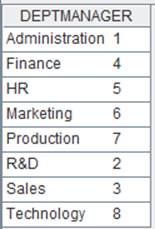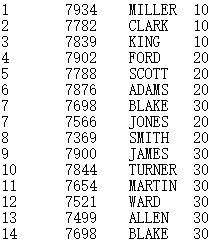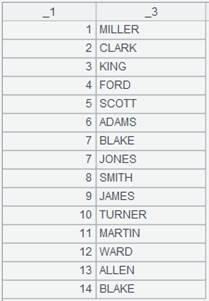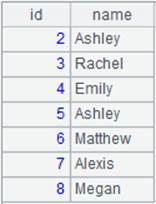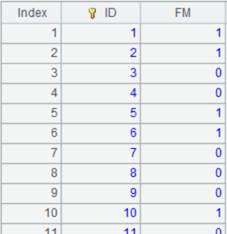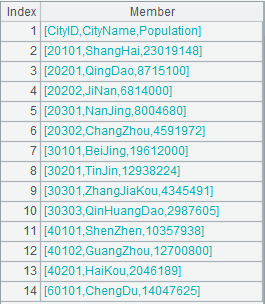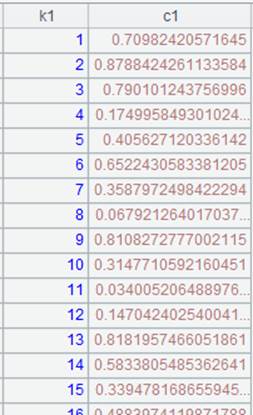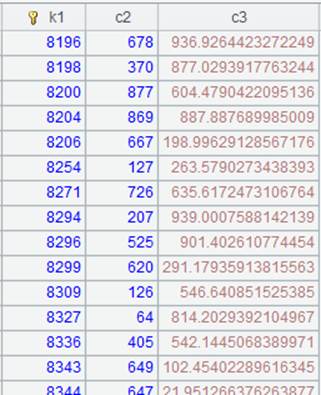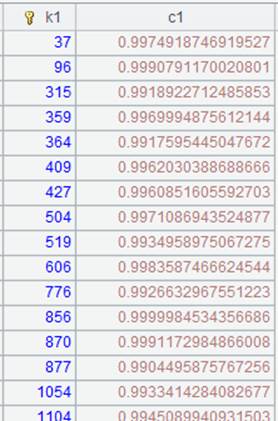f.cursor()
Description:
Create a cursor based on a file.
Syntax:
f.cursor()
f.cursor(Fi:type,…; k:n,s)
Note:
The function creates a cursor based on file f and returns it. The cursor will be automatically closed after a full data scan.
Parameter:
|
f |
File object, only supporting the textual file object |
|
Fi |
Fields to be retrieved; all fields will be retrieved by default. The to-be-retrieved field(s) can be represented by their sequence numbers headed by the sign # |
|
type |
Field types, including bool, int, long, float, decimal, string, date, time and datetime. Data type of the first row will be used by default |
|
s |
User-defined separator. The default is tab. When the parameter is omitted, the comma preceding it can be omitted, too |
|
k |
The segment number |
|
n |
The number of segments. Retrieve the whole file when both k and n are omitted |
Option:
|
@t |
Use the first row of f as the field names. If omitted, use_1,_2,… as the default field names |
|
@b |
Retrieve data from a binary file written in the method of export, with the support of parameters Fi, k and n, and without support of parameters type and s. Ignore options @t, @s, @i, @q, @a, @n, @k, @p, @f, @l, @m, @c, @o, @d, @v and @r. The segmental retrieval could result in empty segment in cases when a file has only a very small number of records |
|
@e |
Make the function return null when Fi doesn’t exist in the file; raise an error when the option is absent |
|
@x |
Delete the source file automatically on closing the cursor; the cursor that the function returns is irreversible when this option works |
|
@s |
Not split the to-be-retrieved field when it is imported as a cursor whose content is a table sequence consisting of strings of a single field; in this case the parameters will be ignored. |
|
@i |
If the result set has only one column, the content of the returned cursor will be a sequence. |
|
@q |
Remove the quotation marks, if any, from both ends of data items, including the field names, and handle escape sequences; but will keep quotation marks within the data item |
|
@c |
Use comma as the separator when parameter s is absent |
|
@m |
With the option, the f.cursor@m(Fi:type,…;n,s) function returns a multicursor; here parameter n is the number of segments; use the value of 【Default subcursor count in a multicursor】defined in the designer as the number subcursors if the option is absent; when integrating esProc into a third-party application, use cursorParallelNum value configured in raqsoftConfig.xml file as the default |
|
@o |
Use quotation marks as the escape character |
|
@k |
Retain white spaces on both sides of the data item; without it white spaces on both ends will be automatically deleted |
|
@d |
Delete a record if it contains unmatching data types or data formats and start examining data by type, or if the parentheses and the quotation marks in it do not match when @p option and @q option respectively are present |
|
@n |
Ignore and discard rows whose number of columns don’t match the first row |
|
@v
|
Throw an exception, terminate the execution and output the content of the problem record when errors appear in @d check and @n check |
|
@w |
Read each row, including the column headers row, as a sequence and return a cursor of sequence made up of sequences |
|
@a |
Treat single quotes as what they are; left not handled by default , and can work with @q@p |
|
@p |
Enable handling the matching of parentheses (not including the separators within the parentheses) and quotes, as well as the escape sequences outside of the quotes |
|
@f |
Split the file content into a string by the separator without parsing |
|
@l |
Allow line continuation if there is an escape character \ at the end of the line |
Return value:
Cursor/Multicursor
Example:
|
|
A |
B |
C |
|
|
|
1 |
=file("D://Student.txt").cursor@tx() |
|
|
Return the cursor for retrieving data, take the record in the first row as field names, and delete the file automatically when closing the cursor. |
|
|
2 |
=create(CLASS,STUDENTID,SUBJECT,SCORE) |
|
|
Construct a new table sequence. |
|
|
3 |
for |
|
|
|
|
|
4 |
|
if A3==1 |
=A1.skip(5) |
If the loop number is 1, then skip 5 consecutive rows. |
|
|
5 |
|
=A1.fetch(3) |
|
Retrieve data from cursorA1, 3 rows each time. |
|
|
6 |
|
if B5==null |
|
Jump out from the loop when B5 is null. |
|
|
7 |
|
|
Break |
|
|
|
8 |
|
else |
|
|
|
|
9 |
|
|
>A2.insert(0:B5,CLASS,STUDENTID,SUBJECT,SCORE) |
Insert records in B5 into A2. |
|
|
10 |
=file("D://Department.txt").cursor@t(Dept,Manager;,"/") |
|
=A10.fetch() |
Below is Department.txt:
Contents of Department. txt are separated with the slashes and read out according to the specified fields of DEPT and MANAGER.
|
|
|
11 |
=file("D://Department5.txt").cursor@t(;1:2) |
|
=A11.fetch() |
With Fi and s omitted, the function separates the cursor into 2 segments and retrieves the first one. |
|
|
12 |
=file("D:// EMPLOYEE. btx").cursor@b(GENDER;1:2) |
|
=A12.fetch() |
Retrieve the GENDER field of the bin file, EMPLOYEE.btx(a segmented binary file) exported through f.export@z(); by default the exported binary file includes field names. |
|
|
13 |
=file("D://EMPLOYEE.btx").cursor@b(;1:2) |
|
=A13.fetch() |
Retrieve the segmented binary file, EMPLOYEE1.btx, exported by f.export@b(), divide the file contents into 2 parts, and get the first part. |
|
|
14 |
=file("D://Department.txt").cursor@ts() |
|
= A14.fetch() |
Won’t split fields, the cursor contains a table sequence consisting of a single string field. |
|
|
15 |
=file("D://StuName.txt").cursor@i() |
|
=A15.fetch() |
StuName.txt is a file containing only one field, so the content of the cursor is a sequence. |
|
|
16 |
=file("D://EMPLOYEE1.txt").cursor@tc() |
|
=A16.fetch() |
|
|
|
17 |
=file("D://Department3.txt").cursor@e(EID) |
|
=A17.fetch() |
Return null since EID field can’t be found in Department3.txt; without @e option, error will be reported, saying EID: field is not found. |
|
|
18 |
=file("D://Department2.txt").cursor@tq(;,"|") |
|
=A18.fetch() |
Below is Department2.txt:
B19’s result:
|
|
|
19 |
=file("D://Department.txt").cursor@tm(DEPT:string,MANAGER:int;3,"/") |
|
|
The cursor is devided into 3 segments and the result of A19 is returned as a multicursor. |
|
|
20 |
=file("D://Sale1.txt").cursor(#1,#3) |
|
=A20.fetch() |
Below is the Sale1.txt file:
Below is the result of B20:
|
|
|
21 |
=file("D:/Dep3.txt").cursor@cqo() |
|
=A21.fetch() |
With @o option, two double quotation marks are treated as one and return the result as follows:
|
|
|
22 |
=file("D:/Dep1.txt").cursor@k() |
|
=A22.fetch() |
Retain the whitespace characters on both sides of the data item.
|
|
|
23 |
=file("D:/Department1.txt").cursor@t(id:int,name;,"|") |
|
=A23.fetch() |
Return id and name fields of Department1.txt.
|
|
|
24 |
=file("D:/Department1.txt").cursor@td(id:int,name;,"|") |
|
=A24.fetch() |
Delete a record containing unmatching data types; rows where id value is a are deleted. |
|
|
25 |
=file("D:/Department1.txt").cursor@tv(id:int,name;,"|") |
|
=A25.fetch() |
Verify data type matching, and, and if error reports, throw an exception, terminate the execution and output the content of the problem record; data type doesn’t match with rows where id value is a.
|
|
|
26 |
=file("D:/Dep2.txt").cursor@tdn(id:int,name,surname;,"|") |
|
=A26.fetch() |
Here’s the file Dep2.txt: Ignore row 6 and row 8 because the number of columns doesn’t match that in row 1.
|
|
|
27 |
=file("D:/Desktop/DemoData/txt/City.txt").cursor@w() |
|
=A27.fetch() |
Use @w option to read each row as a sequence and return a cursor of sequence whose members are sequences.
|
|
|
28 |
=file("D://t1.txt").cursor@c() |
|
=A28.fetch() |
Below is t1.txt:
With @c option, use the comma as the default separator and return result as follows:
|
|
|
29 |
=file("D://t1.txt").cursor@cp() |
|
=A29.fetch() |
With @p option, parentheses and quotation marks matching will be handled during parsing.
|
|
|
30 |
=file("D://t1.txt").cursor@cpa() |
|
=A30.fetch() |
With @a option, single quotes are treated as quotes.
|
|
|
31 |
=file("D://t2.txt").cursor@l() |
|
=A31.fetch() |
Below is t2.txt:
With @1 option, allow line continuation when there is an escape character at the end of the line.
|
|
|
32 |
=file("D://t3.txt").cursor@f() |
|
=A32.fetch() |
With @f option, just splt the file as a string using the separator.
|
|
Related functions:


